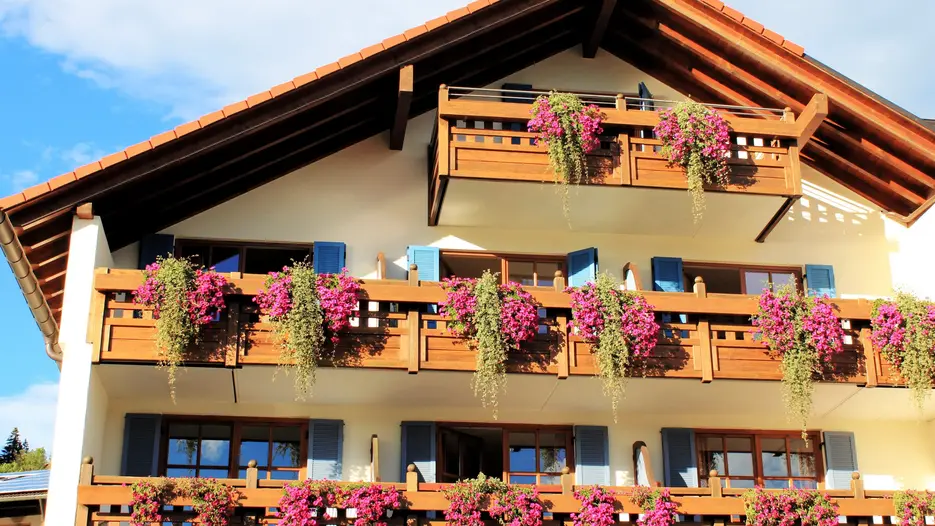“Garmisch-Partenkirchen is ideal for investigating this issue. With a population of about 18,000 inhabitants the market town has urban dimensions, but is more rural in character, especially as far as social structures and architecture are concerned. At the same time, it is one of the oldest and most important destinations in Germany and has a high tourism intensity and tourism-driven demand for residential real estate,” say Professor Dr. Christian Steiner and Dr. Gerhard Rainer. For the case study they have compiled data on the real estate market and income structure and have interviewed stakeholders from tourism, real estate, finances as well as local policy-makers. Besides the two researchers, the team also comprised Dr. Frank Zirkl and Theresa Kors, who is currently doing her PhD on this topic.
In January last year, vacation apartments and houses amounted to 900 with a total of over 4,800 beds. This means that within one year this segment alone has increased by about 25 percent or 1,100 beds. From 2014 to 2020, purchase prices for building land have almost doubled. In the same period, rents have also risen by 37 percent - far above the average increase in gross monthly salaries. At the same time, however, incomes in Garmisch-Partenkirchen are below the national average. “Only wealthy locals, who already own property, and especially non-local buyers are in a position to purchase real estate in Garmisch. If this price dynamic doesn’t slow down significantly, we can assume that the social situation will polarize even further,” the research team write in their article. This could also increasingly become a problem for local and regional (tourism) industries, as they are beginning to struggle to attract employees in a country that is already short of skilled workers.
The researchers see a key aspect for this development in the fact that significantly higher returns can be achieved by renting out to tourists than by renting out to long-term tenants. “One vacation rental owner reported that financial motives had prevailed, when he decided to build and rent out his new vacation apartment building. His decision had had nothing to do with a wish to do something in tourism. Favorable financing conditions were the inducement to erect a building on his family estate,” says Theresa Kors. Higher rental yields on vacation homes, more flexibility in renting and tax advantages were the deciding factors in creating vacation homes instead of entering into a fixed lease, she says.
“There is a very real risk that the working local population will be pushed out of the area in favor of tourists, wealthy locals and rich out-of-town buyers. This intensifying trend goes against the principles of rural and urban development, that is also meant to be socially sustainable.
Other popular tourist destinations in the country, such as Berchtesgaden or Sylt, are facing similar challenges. That is why the results of the case study raise questions that go far beyond mere questions of sustainable regional development in tourism areas in Germany. Without consistent action, the dynamics of real estate are threatening to make sustainable regional and sustainable tourism development in small towns and rural areas impossible.
If policy-makers intended to counteract such tendencies, measures might be taken as part of local land use planning. For example, local authorities might pursue active land transfer policies by buying land that is being rezoned and selling it at reduced rates and more than before in consideration of social criteria exclusively to locals or local workers for constructing homes. In Garmisch-Partenkirchen in particular, additional areas would also be needed for houses for non-tourist purposes, which could be developed, for example, as part of of targeted redensification and an development of preexisting roof areas.
Based on the research results of the team's current investigations in Garmisch-Partenkirchen, they are now planning to explore Oberstdorf and Berchtesgaden. In this follow-up project the researchers want to focus on the question of what innovative spatial planning and private-sector instruments can be used effectively to counteract this development. This project will also be funded by the Bavarian Center for Tourism. "In doing so, we want to provide a basis for exchange and a vital information database on the links between tourism and real estate markets not only for tourism science, but also for decision-makers in politics and tourism. This will ensure that places with a strong tourism industry remain attractive for locals and professionals in the long term," says Professor Steiner.
The full version of the scientific article “Tourismus, freizeitorientierte Migration und Wohnimmobilienmarktentwicklung” was published in the journal “Standort - Zeitschrift für angewandte Geographie” and is available in German at https://doi.org/10.1007/s00548-022-00790-6
